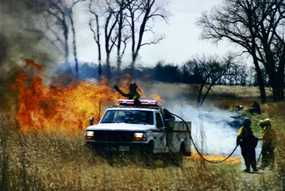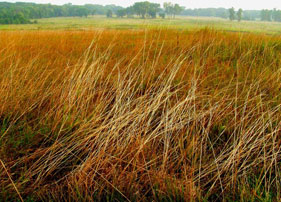Overview
Homestead National Historical Park in southeastern Nebraska was established in 1936 at the site of Daniel Freeman’s original homestead from 1863. Encompassing 100 acres of tallgrass prairie that had been converted into agricultural land and 60 acres of woodland fringing a creek, the monument underwent restoration by the National Park Service in 1939 in an attempt to restore the prairie that Freeman would have discovered upon his arrival at the site. Ongoing for more than 60 years, the Homestead restoration is the nation’s second oldest tallgrass prairie restoration project behind Curtis Prairie at the University of Wisconsin-Madison Arboretum. Recently reported findings from National Park Service monitoring activities have shown that the restored Homestead Prairie exhibits the species diversity and distribution characteristic of a functioning native prairie.
Quick Facts
Project Location:
Homestead National Monument, Nebraska 4, Beatrice, NE, USA, 40.29138409999999, -96.8357934
Geographic Region:
North America
Country or Territory:
United States of America
Biome:
Grassland/Savanna
Ecosystem:
Grasslands & Savannas - Temperate
Area being restored:
100 acres
Project Lead:
National Park Service
Organization Type:
Governmental Body
Location
Project Stage:
Implementation
Start Date:
2007-08-16
End Date:
2007-08-16
Primary Causes of Degradation
Agriculture & LivestockDegradation Description
When the monument was established by Congress in 1936, the upland slopes of the site were severely eroded, the lower slopes were covered with heavy depositions of silt, and the woodlands were cut over and heavily grazed. At least 40 acres of the site were under cultivation as late as November 1939.
Project Goals
To restore the landscape to tallgrass prairie in order to reduce soil erosion and approximate the original conditions of the site when it was first settled in 1863.
Monitoring
The project does not have a monitoring plan.
Description of Project Activities:
The following is a timeline of major restoration activities: 1939- Park records indicate that the first seeding took place in 1939 with seed gathered from a prairie located approximately 5 miles to the west. The approximate seed mixture was 45% big bluestem, 50% little bluestem, and 1% each of Kentucky bluegrass, needleandthread, indiangrass, prairie dropseed and sideoats grama. This original restoration also included the installation of native plant plugs and the transplantation of sod from local areas of unploughed prairie in an attempt to control severe sheet, rill, and gully erosion on the coarse-textured south upland slopes. The source of the sod is unknown.
1942- Additional seeding and sodding, along with the construction of small check dams to slow erosion.
1943-Weed control; sunflowers were mowed and bindweed was treated with sodium chlorate.
1947- Sodding in upland gullies; seeding and local prairie hay mulch used in eroding areas.
1948- Additional spot seeding; sod added to the uplands; selective grazing suggested as a means of reducing fire hazard.
1949- First use of herbicide other than sodium chlorate (2,4-D).
1951- 40 acres mowed.
1952- Upland hayed.
1953- Bottomland hayed.
1954- Seeds harvested
1955- Smooth bromegrass infestation noted.
1963- 2,4-D used for weed control.
1964- Lowlands heavily infested with weeds. Dalapon used for smooth brome control and 2,4-D for broadleaf weeds.
1965- Thatch buildup leads to complete mowing.
1968- Smooth brome mowed.
1969- 7-11 acres of lowland seeded.
1970- First prescribed burn to manage the prairie; 2,4-D applied.
1976- 4 acres of lowland reseeded.
1979- Woody plants sprayed with ammonium sulfamate; routine 2,4-D spraying program stopped.
1980- 17-acre wildfire occurred.
1982- Quantitative vegetative sampling begun; prescribed burn in April (8 acres); manual removal of musk thistles and common mullein.
1983- Entire prairie burned, 4 acres of weedy lowland mowed.
1984- Weedy lowland mowed; fall burn of small overgrown sumac; herbarium assembled.
1986- Lowland area sodded and planted with approximately 3,000 greenhouse grown seedlings from locally collected prairie seed.
Ecological Outcomes Achieved
Eliminate existing threats to the ecosystem:
Today, the species composition of the tallgrass prairie at Homestead resembles that of presettlement times. In fact, plant diversity is greater in the oldest sections of the restored prairie than in some native prairie remnants in the area. There are 116 species of plants present at the site, and dominant species include: big bluestem, little bluestem, Indiangrass, switchgrass, goldenrod, field pussytoes, and leadplant. Interspersed within the prairie are thickets of shrubby species such as sumac, wild plum, and dogwood, which provide habitat for birds and other small animals. (see attached lists of bird and mammal species)
A report produced by the National Park Service in 2007 presented the findings of sampling exercises conducted at monitoring sites between 1998 and 2006. Based on the data collected at these sites, it is concluded that the 100 acres of restored prairie at Homestead National Monument reflect the species richness and diversity of the prairie's historic source and native species augmentation. It is a species-rich plant community with a distribution pattern composed of core and satellite species (Hanski 1982). There are a few abundant (core) species that give the prairie its unique and enduring characteristics--i.e. summer/fall forbs and warm-season grasses such as big bluestem (Andropogon gerardii Vitman) and little bluestem (Schizachyrium scoparium (Michx.) Nash)--and numerous (satellite) species occurring either in low abundance or patchily distributed (Grubb 1986). The high degree of species composition similarity between sites and sample years (evenness), along with only 47% of annual species represented within each site on average, illustrates this core-satellite community structure in the prairie. Although it is difficult to make a quantitative comparison of the restored prairie with a mid-1860s prairie, the core-satellite distribution of species reflects a functioning native prairie.
Socio-Economic & Community Outcomes Achieved
Long-Term Management
The park monitors for nonnative species in the prairie and woodland areas of the monument and uses a combination of techniques, including mowing, selective use of herbicides, and prescribed fire, to manage these areas.
Prescribed burning began in 1970. The prairie is divided into six management units and burned on a seven-year cycle. Every year, two units are randomly chosen for treatment, with the stipulation that once a unit has been burned twice in the seven-year period, it is removed from consideration for the duration of that period. Seasonality of fires is also randomized. The seventh year is a “rest year.” The goals of the fire management program are control of exotic species such as smooth brome, management of shrub species to no more than 15% of the prairie by area, and removal of plant debris that, if left in place, creates the potential for a large, devastating fire.
Sources and Amounts of Funding
Funding for the Homestead Prairie restoration has been provided through the U.S. Department of the Interior, National Park Service.



